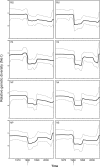Genome-scale evolution and phylodynamics of equine H3N8 influenza A virus
- PMID: 21430049
- PMCID: PMC3094979
- DOI: 10.1128/JVI.02619-10
Genome-scale evolution and phylodynamics of equine H3N8 influenza A virus
Abstract
Equine influenza viruses (EIVs) of the H3N8 and H7N7 subtypes are the causative agents of an important disease of horses. While EIV H7N7 apparently is extinct, H3N8 viruses have circulated for more than 50 years. Like human influenza viruses, EIV H3N8 caused a transcontinental pandemic followed by further outbreaks and epidemics, even in populations with high vaccination coverage. Recently, EIV H3N8 jumped the species barrier to infect dogs. Despite its importance as an agent of infectious disease, the mechanisms that underpin the evolutionary and epidemiological dynamics of EIV are poorly understood, particularly at a genomic scale. To determine the evolutionary history and phylodynamics of EIV H3N8, we conducted an extensive analysis of 82 complete viral genomes sampled during a 45-year span. We show that both intra- and intersubtype reassortment have played a major role in the evolution of EIV, and we suggest that intrasubtype reassortment resulted in enhanced virulence while heterosubtypic reassortment contributed to the extinction of EIV H7N7. We also show that EIV evolves at a slower rate than other influenza viruses, even though it seems to be subject to similar immune selection pressures. However, a relatively high rate of amino acid replacement is observed in the polymerase acidic (PA) segment, with some evidence for adaptive evolution. Most notably, an analysis of viral population dynamics provided evidence for a major population bottleneck of EIV H3N8 during the 1980s, which we suggest resulted from changes in herd immunity due to an increase in vaccination coverage.
Figures





References
-
- Adeyefa C. A., Quayle K., McCauley J. W. 1994. A rapid method for the analysis of influenza virus genes: application to the reassortment of equine influenza virus genes. Virus Res. 32:391–399 - PubMed
-
- Banbura M. W., Kawaoka Y., Thomas T. L., Webster R. G. 1991. Reassortants with equine 1 (H7N7) influenza virus hemagglutinin in an avian influenza virus genetic background are pathogenic in chickens. Virology 184:469–471 - PubMed
-
- Bean W. J. 1984. Correlation of influenza A virus nucleoprotein genes with host species. Virology 133:438–442 - PubMed
Publication types
MeSH terms
Grants and funding
LinkOut - more resources
Full Text Sources

